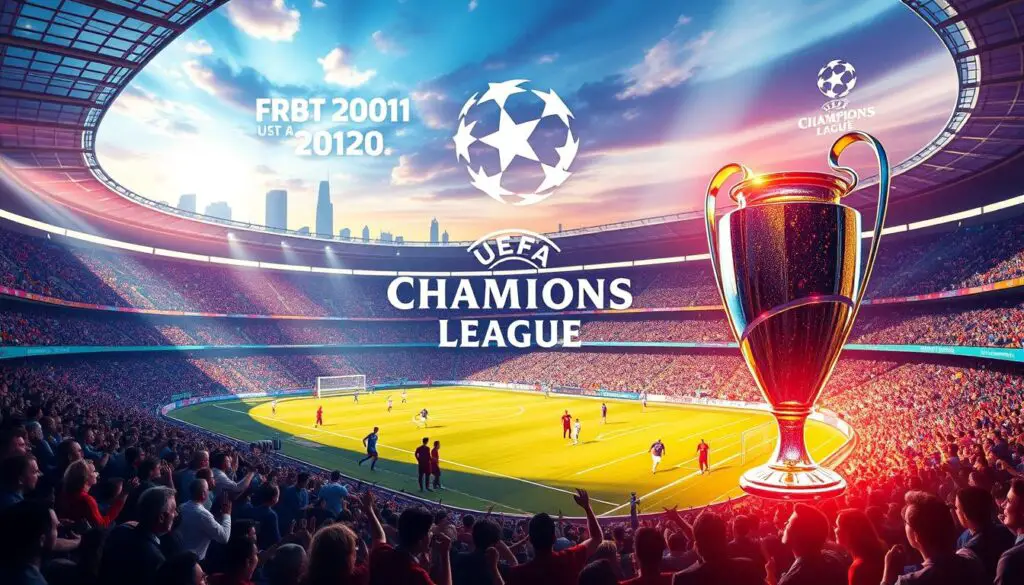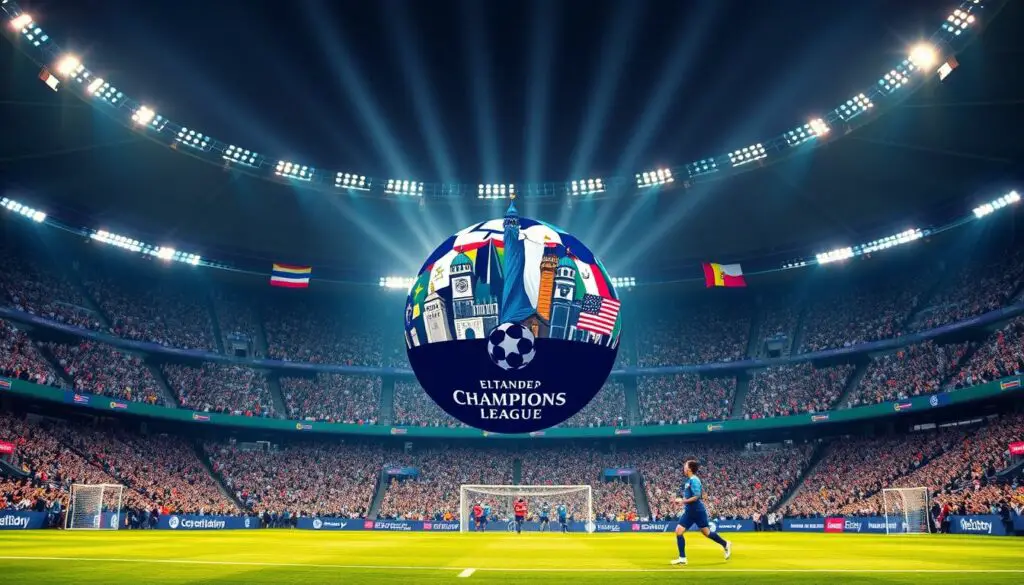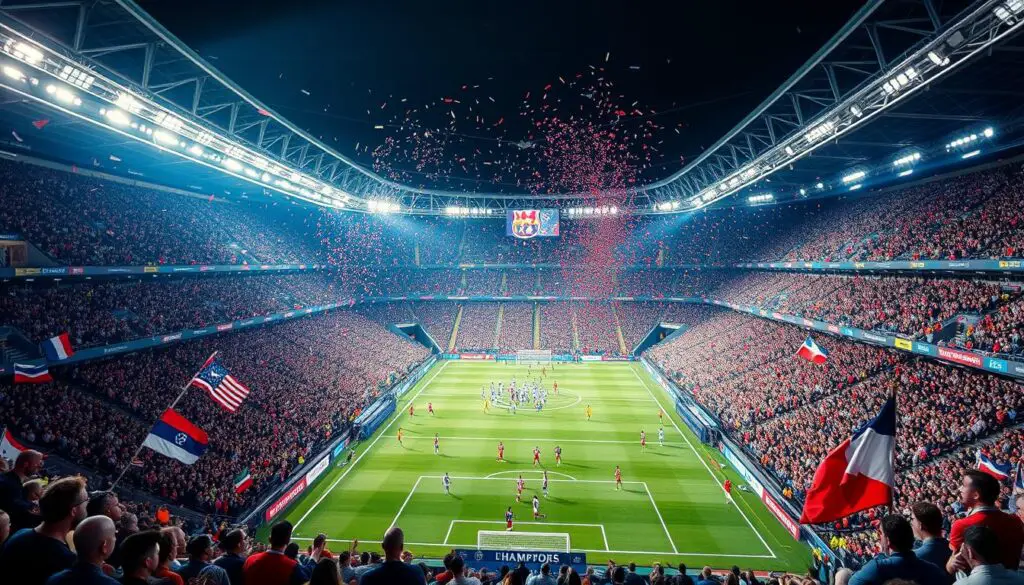The UEFA Champions League, the top of European club football, is changing big time starting 2024/25. UEFA, the European football’s top body, is making the tournament better for fans and TV viewers. They want to make it more exciting and appealing.
The new format will have 36 teams and a new single-league phase. This is a big change from the old group stage. UEFA is trying to make European club football better for everyone involved.

Key Takeaways
- UEFA is making big changes to the Champions League format starting 2024/25.
- The new format will have 36 teams in a single league phase, not the old group stage.
- The changes aim to make the competition more exciting for fans and TV viewers.
- These changes are part of UEFA’s plan to improve European club football.
- The new format will change how the Champions League works and feels.
Understanding the Evolution of Champions League Format
The UEFA Champions League has seen big changes over time. It has moved from its old structure to new format changes. These changes aim to keep up with the modern game and the changing world of European football.
Historical Structure and Previous Format
The Champions League, once the European Cup, was a simple knockout tournament. It featured the top clubs from each league. Later, it added a group stage with 32 teams in eight groups of four. Critics said this format was not competitive enough and had too few exciting matches.
The Need for Change in European Football
There was a need for a more exciting Champions League format. The old format was seen as too predictable. Fans and teams wanted more thrilling matches.
Key Drivers Behind the Format Revision
Several factors led to the Champions League format changes. Money, TV rights, and keeping the tournament’s top spot were key. UEFA wanted to make more money, attract more viewers, and keep the Champions League as the best club football competition.
| Year | Format | Number of Teams |
|---|---|---|
| 1992-1994 | Knockout Tournament | 32 |
| 1994-2003 | Group Stage + Knockout | 24 |
| 2003-2009 | Group Stage + Knockout | 32 |
| 2009-2018 | Group Stage + Knockout | 32 |
| 2018-2024 | Group Stage + Knockout | 32 |
| 2024-present | Swiss Model League Phase + Knockout | 36 |
The UEFA Champions League has changed a lot over the years. It has moved from a simple knockout format to the Swiss model league phase. These changes aim to make the competition more exciting for teams and fans.
UEFA Champions League New Format
The UEFA Champions League, the top club football competition in Europe, is changing. A new format is coming to make the tournament more competitive. It will give teams more chances to show their skills on the big stage.
The new format has a single league phase. All 36 teams will play against different opponents. They will play eight matches, with their opponents chosen by a seeding system. This change means teams will face a variety of challenges, unlike the old group-stage format.
- The top eight teams will automatically qualify for the round of 16. They’ll make sure of their spot in the knockout stages.
- Teams 9th to 24th will play in play-off matches. They’ll fight for the last eight spots in the round of 16.
This new structure is part of UEFA’s reforms. It aims to make the Champions League more exciting and unpredictable. Teams will have to perform well consistently to make it far in the tournament.
| New Champions League Format Details | Impact |
|---|---|
| Single league phase with 36 teams | Increased competition and diversity of opponents |
| Each team plays 8 matches | More opportunities for teams to showcase their talents |
| Top 8 teams automatically qualify for round of 16 | Greater emphasis on consistent performance |
| Teams 9-24 compete in play-offs for 8 remaining spots | Heightened drama and unpredictability in the knockout rounds |
These changes are a big step forward for European club football. They promise a more exciting and unpredictable tournament for players and fans.
“The new Champions League format will bring a fresh dynamic to the competition, ensuring that teams must consistently perform at the highest level to secure their place in the latter stages of the tournament.”
Team Expansion and Qualification Process
The UEFA Champions League is getting a big change. It will now have 36 teams, up from 32. This means more clubs from European leagues can join the competition.
Increase to 36 Teams
Having 36 teams is a big deal. It gives clubs more chances to play in the Champions League. This change will show off the skills of top clubs from all over Europe.
New Qualification Criteria
The rules for getting into the Champions League have changed too. Two more spots will be given out based on how well clubs do. This helps clubs that aren’t always in the top leagues to get a chance.
Distribution of Teams Across Leagues
The 36 teams will be divided up. 22 will go to the top five leagues in Europe. The rest will go to other leagues based on how well they do. This could let new teams into the Champions League.

“The Champions League reforms represent a significant step forward in ensuring greater representation and opportunities for clubs across Europe. This expansion will undoubtedly add excitement and unpredictability to the tournament, keeping fans on the edge of their seats.”
The Swiss Model League Phase
The revamped UEFA Champions League structure introduces a groundbreaking “Swiss Model” for the league phase. It replaces the traditional group stage format. All 36 teams will now compete in a single league, facing eight different opponents in competitive matches.
The Swiss Model aims to provide a more dynamic and diverse playing experience. Matchups will be determined by seeding, ensuring a mix of opponents from various strength levels. This system promises to deliver a higher caliber of play, with teams facing a wider range of challengers.
| Key Aspects of the Swiss Model | Description |
|---|---|
| Total Teams | 36 |
| Matches per Team | 8 |
| Match Opponents | Varied strength levels, determined by seeding |
| Objective | Provide more diverse and competitive matches throughout the league phase |
The introduction of the Swiss Model represents a significant departure from the previous Champions League format. This innovative approach aims to enhance the overall quality and excitement of the tournament. It promises to deliver a more engaging experience for fans and teams alike.

Points System and Match Structure
The UEFA Champions League is changing, but the points system and match structure stay the same. Teams get three points for winning, one for drawing, and zero for losing. This keeps the excitement and competition that fans love at the heart of the tournament.
Home and Away Dynamics
The Champions League is now more balanced with home and away matches. Each team plays four games at home and four away. This makes the competition fairer, letting teams show their skills at home and away.
Match Distribution Format
The new champions league format update changes how matches are set up. Teams face different opponents from various seeding pots. This keeps the tournament exciting and unpredictable, as teams must adjust to many challenges.
| Points Awarded | Home Matches | Away Matches | Opponent Diversity |
|---|---|---|---|
| 3 for a win, 1 for a draw, 0 for a loss | 4 | 4 | Facing opponents from different seeding pots |
The UEFA club tournament restructuring and champions league competition format revision aim to make the competition more thrilling. They keep the traditional elements that make the Champions League a favorite among football fans worldwide.
Impact on European Club Football
The UEFA Champions League’s new format will change European club football a lot. This new structure will change how teams make money, compete, and schedule games. It will affect the top leagues and competitions in the continent.
One big change is more money for teams. With more games and teams, there will be more chances for TV deals and sponsorships. This means top clubs can spend more, making the gap between rich and poor teams bigger.
The new Champions League will also change how players play in domestic leagues. Clubs will have to manage their players better because of more European games. This might lead to changes in league schedules and how teams use their players.
Also, the way teams qualify and are placed in leagues could change the balance of power. Smaller league clubs might find it harder to get into the Champions League. This could make it tough for them to attract top players and keep up financially with bigger clubs.
“The new Champions League format will undoubtedly reshape the financial landscape of European football, with significant implications for the continent’s top clubs and leagues,” said sports finance expert, Dr. Emma Raducanu. “Careful management of player workloads and strategic roster adjustments will be crucial as clubs navigate this evolving landscape.”
The UEFA Champions League’s new era will have big effects on European soccer. Clubs, leagues, and governing bodies will need to adjust. They must balance sports fairness, financial health, and keeping fans happy.
| Key Impact Areas | Potential Outcomes |
|---|---|
| Revenue Generation | Increased broadcast rights and commercial partnerships, widening financial gap between elite and smaller clubs |
| Competitive Balance | Challenges for smaller league clubs to qualify, potential shift in the balance of power |
| Scheduling and Workload | Adjustments to domestic league calendars, more squad rotation and player management strategies |
Conclusion
The new UEFA Champions League format is a big change in European club football. It aims to make the competition more exciting and profitable. But, it also brings challenges like scheduling and how it might affect domestic leagues.
UEFA’s changes will be watched closely by everyone in football. The success of this new format is still uncertain. It’s important to balance the needs of top clubs, smaller leagues, and fans for the UEFA Champions League’s future.
The UEFA champions league changes and European elite club tournament restructuring are major steps for the sport. As the football world adjusts, the next few years will be key in shaping the game’s future.
FAQ
What are the key changes in the new UEFA Champions League format?
The new format will have 36 teams in a single league phase. This replaces the old group stage. Each team will play 8 matches against different opponents, based on seeding.
The top 8 teams will get a direct spot in the round of 16. Teams 9th to 24th will compete in play-offs for the last 8 spots.
Why is the UEFA Champions League format being revamped?
The format change aims to offer more quality matches and boost competition. Financial gains, better broadcast deals, and keeping the tournament’s prestige are key reasons.
How does the new Swiss model league phase work?
The Swiss model replaces the old group stage. All 36 teams will be in one league, playing 8 matches against different opponents. Matchups are based on seeding, ensuring a mix of opponents.
How are the 36 teams distributed across European leagues?
The expansion to 36 teams brings more teams from European leagues. Two extra spots are given based on club coefficient rankings. One goes to the third-ranked club in the fifth-ranked association, and one to a domestic champion.
Twenty-two teams will come from the top five leagues. The rest will be from other leagues, based on performance and rankings.
What are the changes in the points system and match structure?
The points system stays the same: three for a win, one for a draw, and zero for a loss. Teams will play four home and four away matches. This ensures a balanced mix of opponents from different seeding pots.
What are the potential implications of the new Champions League format?
The new format could greatly change European club football. It might bring in more money from broadcast rights and sponsorships. It could also affect domestic league schedules and player workloads.
It might also change how clubs from different leagues and financial backgrounds compete.
















